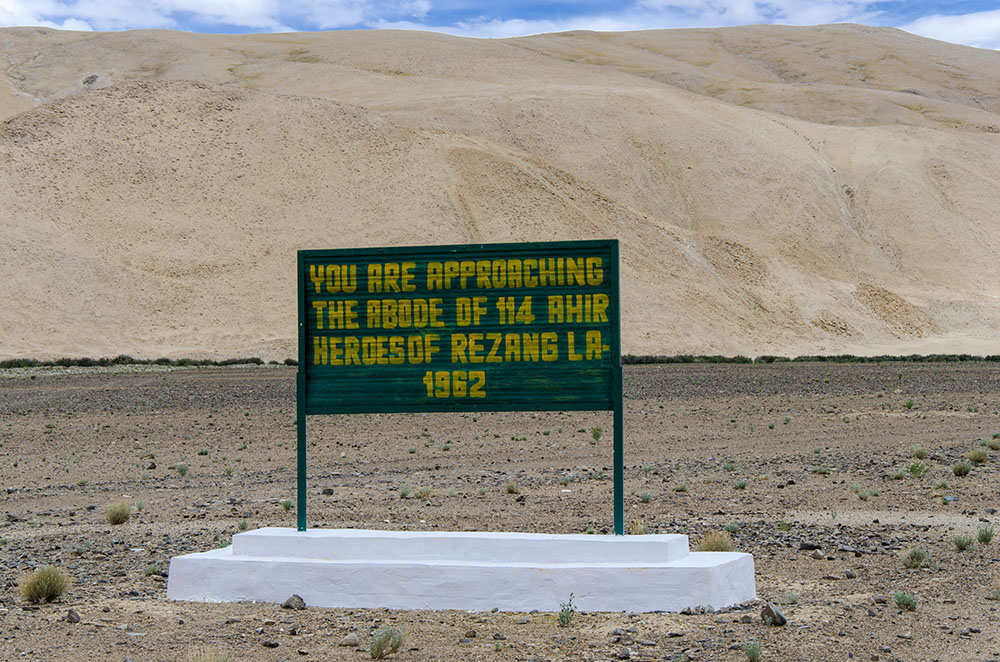 Rezang La, the name doesn’t ring a bell for many. A few who have traveled to Ladakh by road would know that it must be a high altitude pass; because of the word “La”. Some who have been fortunate enough to travel through the Changthang region in Ladakh would know of its exact location. But only a handful know of the acts of heroism that went down here.
Rezang La, the name doesn’t ring a bell for many. A few who have traveled to Ladakh by road would know that it must be a high altitude pass; because of the word “La”. Some who have been fortunate enough to travel through the Changthang region in Ladakh would know of its exact location. But only a handful know of the acts of heroism that went down here.
This hilltop and the nearby village of Chushul once became a matter of national honor; a place where 114 brave Indian soldiers laid down their lives in the Sino – Indian War of 1962.
About Rezang La
Rezang La is a pass on the south-eastern approach to Chushul Valley in Ladakh. Due to its length of 2.74 kilometers and width of 1.8 kilometers, it does not even seem like a pass. The ascent is not steep at all and you will cross the pass without even realizing that you just crossed one.
At the height of 16000 ft, sits the Rezang La war memorial. This is probably the only landmark that will tell you that you are on a high-altitude pass.
Also read: How to Plan a Trip to Ladakh – A Complete Travel Guide
Rezang La connects the Chushul Valley with the rest of the country. Due to its close proximity to the India-China border, it is a highly sensitive area. Civilians [except for the locals] are not allowed to enter the region without an Inner Line Permit that one has to obtain from the District Magistrate’s office in Leh. Foreign nationals are not permitted to visit the area at all.
The Conflict
It all began with the 1959 Tibetan uprising. India granted asylum to the Dalai Lama and initiated a forward policy in which it placed outposts on the border along the McMahon Line. This was agreed upon as the actual border between India and China in the 1914 treaty.
Chinese however dishonored the treaty in 1959. They came up with a “Line of Actual Control” making the entire region of Aksai Chin Chinese territory. India, having freshly acquired independence, tried to gain the control back. The Indian Army placed several posts along the McMahon line, claiming Aksai Chin as part of India.
This triggered simultaneous Chinese offensives in Ladakh and across the McMahon Line on 20 October 1962. Chinese troops advanced over Indian forces in both territories. They captured Rezang la in Chushul in the western territory, as well as Tawang in the eastern.
Also read: Tourist Attractions in Ladakh – A Comprehensive List
The war ended when the Chinese declared a ceasefire on 20 November 1962. They retreated beyond what they agreed upon as the actual border of India and China. The end result of the war was the entire Western region of Aksai Chin (equal to Switzerland in size) falling out of India’s hands into the Chinese.
The Battle at Rezang La
That morning of November 18th was a very cold one with icy winds howling through Rezang La, biting and benumbing. A total of 120 men of Charlie Company, of a battalion called 13 Kumaon, under the command of Major Shaitan Singh were posted atop Rezang La. The Company was divided into several platoons on one ridge of two kilometers; protecting the airstrip of Chushul which was vital if India was to hold Ladakh.
A crest behind this ridge prevented Indian artillery from being able to support these jawans. Platoon 9 was posted at the front in order to stop the Chinese advance from Tsaga La. Platoons 7 and 8 were posted on either side of the ridge to stop them from flanking Indian posts.
Major Shaitan Singh and his men were the last line of defense that stood in the way of Chinese Troops; keeping them from taking over Chushul Valley which would further have weakened India’s grasp on the entire Ladakh. It has been snowing for the last few days in the entire Chushul Valley, and the pass of Rezang La were under a thick layer of snow.
The Attack
That night was particularly very cold because of a snowstorm. It lasted for over 2 hours and none of the men could sleep; trying hard to stay warm and awake. In the dark of the night, the Chinese were seen advancing through nullahs to attack No.7 and No.8 platoon positions. The Indian troops fell on their prepared positions to face the enemy offensive.
Also read: How to Plan a Trip to Umling La
The attack started at 3.30 AM at the section of Naik Gulab Singh (Vir Chakra) of Platoon 8. Chinese soldiers were trying to climb up the ridge to Rezang La but the LMG of Hukam Chand (Vir Chakra) failed their attempts for a while. The command post was immediately informed. After 10 mins Surja Ram (Vir Chakra) of Platoon 7 also reported being under attack.
The Chinese Offense
It was a regiment of 400 Chinese soldiers that came face to face with only a handful of Indian soldiers at both Platoon 7 and 8. They were trying to climb up from 14,000 ft to 18,000 ft but the first attack was repulsed. It is said that the total strength of Chinese troops that morning was in thousands with heavy artillery support and hence the attacks never stopped.
Wave after wave, the Chinese soldiers kept trying to climb up the two-kilometer ridge. Platoon 9 was posted at the front but was initially not attacked. Chinese plan, as it would seem so, was to climb up from both sides and isolate Platoon 9 but their first few attempts were wasted by Platoon 7 and 8.
Also read: Why you should NEVER visit Ladakh
At 0500 hours when the visibility improved both platoons opened up heavily on the advancing enemy with rifles, light machine guns, grenades, and mortars. The nullahs were soon littered with dead bodies of Chinese soldiers. There were a high number of casualties on the Chinese side with hundreds of dead bodies lying around. The legend has it that so many of them died that morning that the surviving Chinese soldiers could easily take cover behind the dead bodies.
Indian soldiers were subjected to intense artillery & mortar fire at about 0540 hours. All the first four attempts of the Chinese Army were in vain and this is when they changed their strategy. This time they attacked with full force from the front at Platoon 9 while another group circled and attacked from behind.
This time, the No.9 Platoon, which held fire till the enemy was within 90 meters opened up with all weapons in their possession. Within minutes, the nullahs were again full of dead bodies.
Major Shaitan Singh Bhati
However, the 450 soldiers strong group of Chinese troops that attacked from the rear of the company position is what proved fatal. At this time, Platoon 7 was over-run and all their communication with the command post stopped. At first, it was thought the advancing soldiers from behind were Indian backup. Soon the soldiers realized that the Chinese have surrounded them from all sides.
Indians tried to use 3-inch mortar in order to break the attack but the Chinese responded to it by heavy artillery and mortar shelling. They simultaneously opened an intense MMG (medium machine gun) fire on the No.8 Platoon. Soon the barbed wire fencing of the post was breached and hence a hand to hand combat started.
Each of the Indian soldiers was a hero that day. Naik Ram Sign (Vir Chakra) was reported to have been seen as holding heads of Chinese soldiers in his hands and smashing them together.
Indian positions were by now very clear to the Chinese troops. They attacked the post of the commanding officer, Major Shaitan Singh, with all might. Indian soldiers had no options but to either shoot them or strangle them with bare hands. The thick parkas Chinese wore made it impossible for the bayonets to penetrate. Platoon 8 too was soon lost and Major Shaitan Singh was seriously wounded.
Captain Yadav
It was chaos all around. This is when Company Havaldar Major Harphool Singh decided that they would not let their Major fall into the enemy’s hands. Captain Ramchander Yadav [now—Honorary] was assigned to carry the Major on his back to the nearest rations base in order to get him medical attention and also to tell the story of the battle that took place that day.
Captain Yadav opened the sling of his rifle, tied Major Shaitan Singh to himself with the belt, joining their bodies together at the waist, and then, slowly, he started to roll downhill.
There was very little life left in the major. After rolling for several hundred yards, Captain Yadav stopped near a boulder to catch his breath. It was 8.15 in the morning and by his watch, Captain Yadav noticed that the Major was no longer alive; because his watch ran by his pulse, and when the pulse stopped, the watch stopped as well.
Also read: Clothes for Ladakh Trip – What to Pack?
Yadav took off the Major’s gloves and slid his body between boulders to hide it so that it remained safe until someone could come to fetch it. Then he made his way down and after coming down about a kilometer, to the point from where their rations were supplied to the post at Rezang La, he saw that the quarter master’s depot was in flames.
They had already left after setting the depot on fire and just when Yadav was wondering what to do, he noticed an Army vehicle heading back towards Indian base and boarded it.
The Heroes of Rezang La
The irony of the incident is that when Yadav returned to the headquarters and told everyone what had happened at Rezang La, no one believed him saying that it was impossible for the 120 men to have killed thousands of soldiers all alone. He was even threatened with court-martial if he kept on telling a tale that was claimed as imaginary.
After the battle was over, out of the 120 Indian soldiers 114 were dead. The bodies were all frozen, with their bayonets still in their hands and bullets in their bodies. The ones that were throwing grenades were found dead with a grenade still in their hands. Wounded soldiers disassembled their LMG and threw it before they died so that the enemy could not use it.
Indian Army suffered heavy losses in Bomdila and NEFA, but the courage of men posted at Rezang La is what made up for it. It was this very battle that broke the back of Chinese advances, and they called for a cease-fire immediately after. The heavy casualties suffered by the Chinese slowed their advance and provided ample time for the Indian Army to fortify defenses at Chushul.
Indians lost at Bomdila, NEFA but Rezang La is where we fought back. It brought about a strategic turnaround in the war of 1962 because it broke the enemy’s momentum.
Close to 1300 Chinese soldiers died that morning at the hands of 120 Indian men. This was a number that was far too great for them to continue the war any further. As expected, they never acknowledged the heavy losses they suffered. As per the Chinese records, the battle at Rezang La was over within 10 minutes.
Also read: How to Handle Acute Mountain Sickness in Ladakh
The Glory
It has been 50 years now and the tales are long forgotten. It’s a war that this country ideally would love to forget, but cannot because it’s etched in our memories as one of the saddest chapters of our independent history. Of the 120 men and officers of this Company, 114 died, five were taken prisoners as wounded, and one was sent back to tell the story of the battle to the rest of the world. All 5 of the war prisoners managed to escape captivity in another heroic attempt.
These men were of an Ahir Company from Rewari in Haryana. This one Company had one Param Vir Chakra, five Vir Chakras, and four Sena medals. Yet, in the 1964 movie Haqeeat which was based on the events of this day, the soldiers were shown of the Sikh regiment. The Ahir Company and its survivors of the war were never acknowledged.
If you have any views or information to share on Rezang La, please feel free to do so at our Community Forum or in the comments section below. If you are going to be in Ladakh anytime soon, be sure to add the pass of Rezang La in your itinerary and pay respect to the 114 men who laid their lives for the honor of their country.

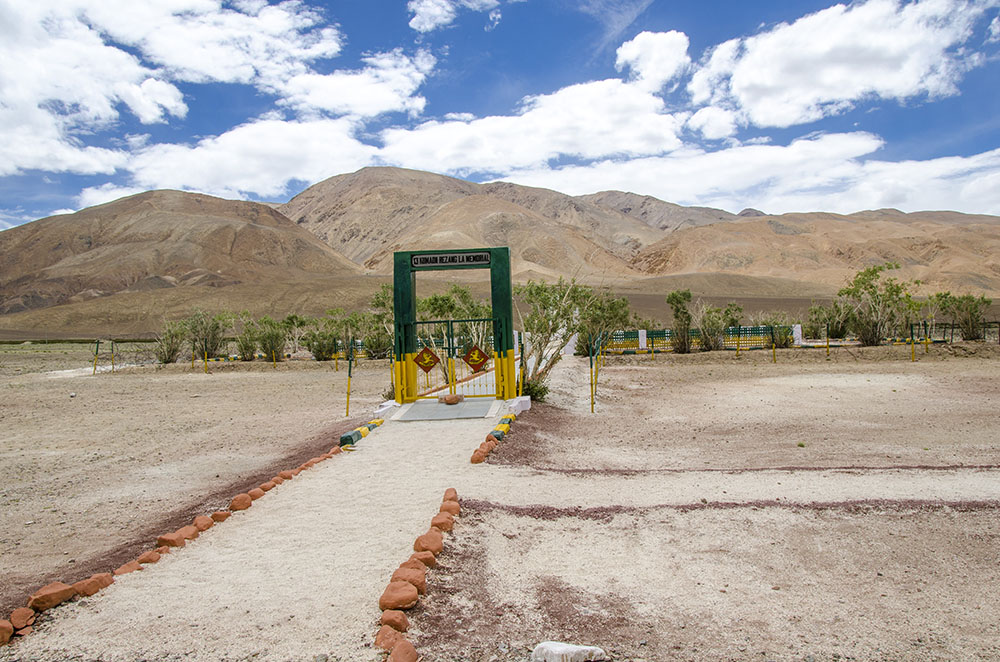
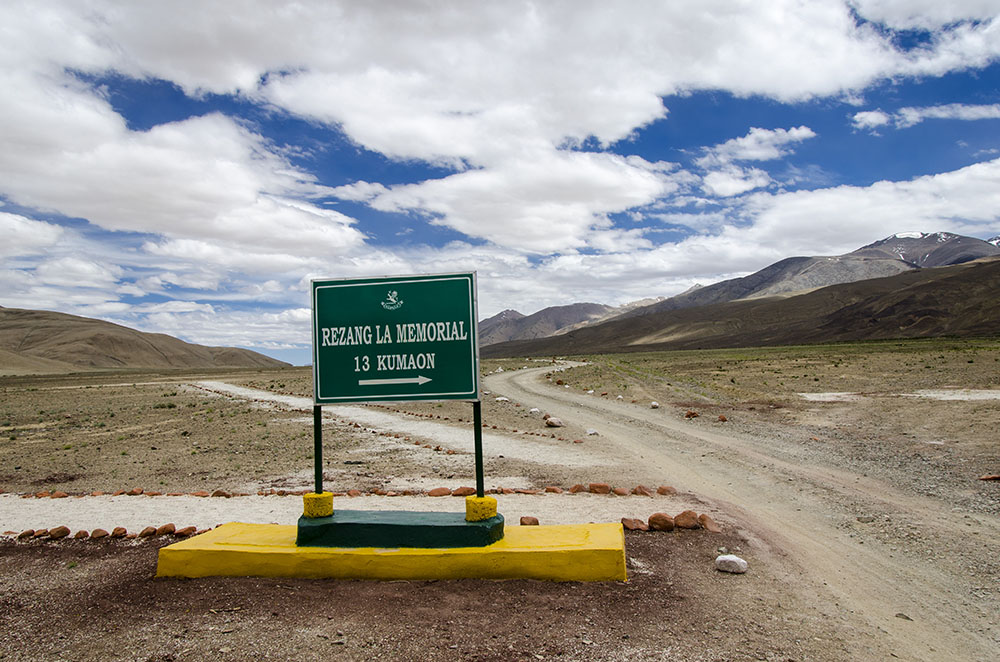
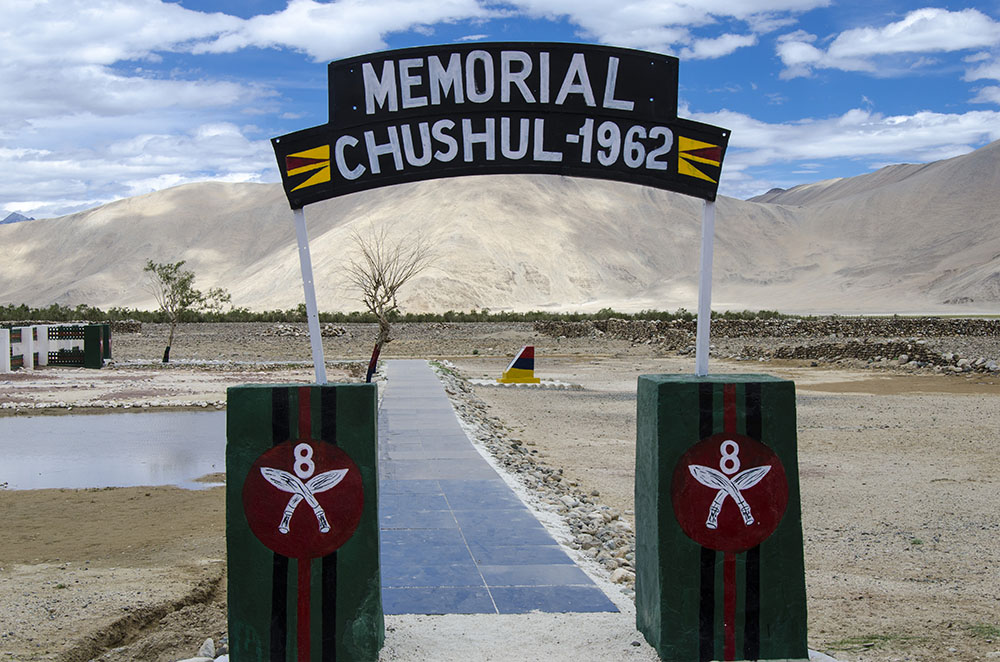
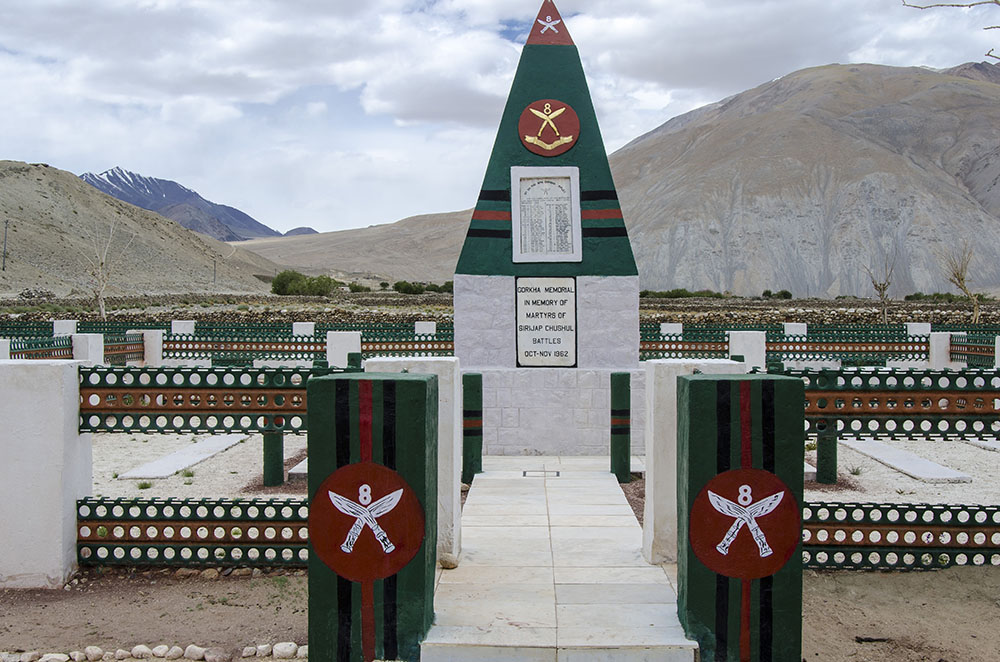
4 comments
Dear Virgis Ji,
I have lately joined in this blog and just read it, while preparing for upcoming Ladakh trip in June’2019.
Thanks for such reminding description about our war heroes ( Maj. Shaitan Singh & Ahir Company) and that plot of war of Rezang-La, held in 1962 and which forced the invaders to rethink their war plan and change the tactics/think for withdraw. As on today, it simply appears un-imaginable and we can only assume such story.Big Salute to such bravery of our army, who laid their life while guarding our border, in such harsh conditions. All these appears to be forgotten form the memory of our countrymen. Simply unbelievable.
As on today, even we are much more than ready, still we need more and more, to be on alert & prepared for such Chinese surprises.
Once again thanks, Vergis Khan Ji.
Yours
Prabhat Kr. Srivastava
Thank you so much for taking the time to drop a note and share your experience Prabhat Ji
Vargis just read this blog as I was surfing for some War memorial material. Well documented. So many of these memorials all along the Leh Ladakh route. Mostly forgotten heroes who gave up their lives for our better future
Thanks Nikheel